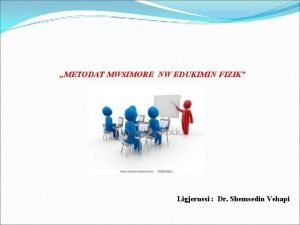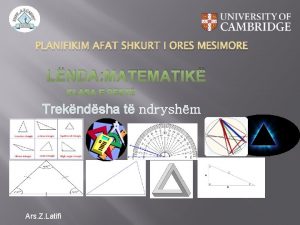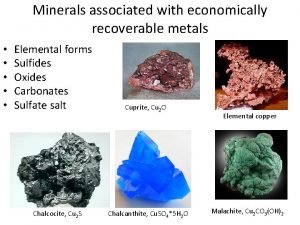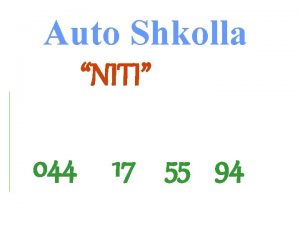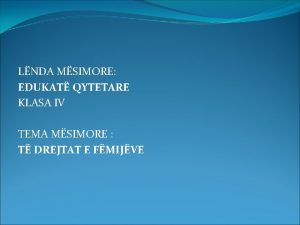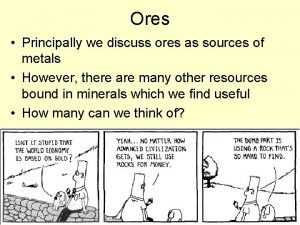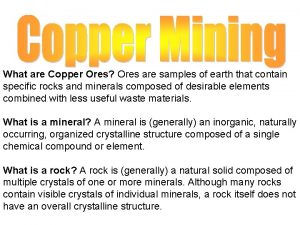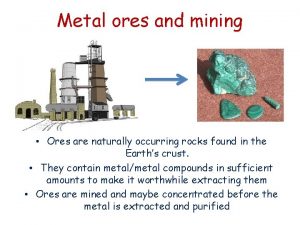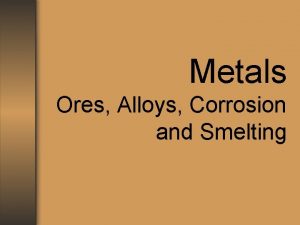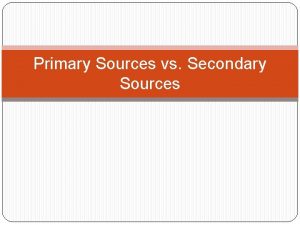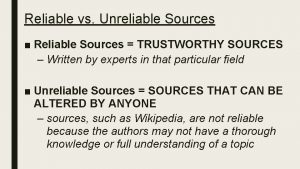Ores Principally we discuss ores as sources of











- Slides: 11

Ores • Principally we discuss ores as sources of metals • However, there are many other resources bound in minerals which we find useful • How many can we think of?

Ore Deposits • A deposit contains an unusually high concentration of particular element(s) • This means the element(s) have been concentrated in a particular area due to some process • What sort of processes might concentrate these elements in one place?

Gold Au • Distribution of Au in the crust = 3. 1 ppb by weight 3. 1 units gold / 1, 000, 000 units of total crust = 0. 00000031% Au • Concentration of Au needed to be economically viable as a deposit = few g/t 3 g / 1000 kg = 3 g/ 1, 000 g = 0. 00031% Au • Need to concentrate Au at least 1000 -fold to be a viable deposit • Rare mines can be up to a few percent gold (extremely high grade)!

Ore minerals • Minerals with economic value are ore minerals • Minerals often associated with ore minerals but which do not have economic value are gangue minerals • Key to economic deposits are geochemical traps metals are transported and precipitated in a very concentrated fashion – Gold is almost 1, 000 times less abundant than is iron

Economic Geology • Understanding of how metalliferous minerals become concentrated key to ore deposits… • Getting them out at a profit determines where/when they come out

Ore deposit environments • Magmatic – Cumulate deposits – fractional crystallization processes can concentrate metals (Cr, Fe, Pt) – Pegmatites – late staged crystallization forms pegmatites and many residual elements are concentrated (Li, Ce, Be, Sn, and U) • Hydrothermal – Magmatic fluid - directly associated with magma – Porphyries - Hot water heated by pluton – Skarn – hot water associated with contact metamorphisms – Exhalatives – hot water flowing to surface – Epigenetic – hot water not directly associated with pluton

Geochemical Traps • Similar to chemical sedimentary rocks – must leach material into fluid, transport and deposit ions as minerals… • p. H, redox, T changes and mixing of different fluids results in ore mineralization • Cause metals to go from soluble to insoluble • Sulfide (reduced form of S) strongly binds metals many important metal ore minerals are sulfides!

Hydrothermal Ore Deposits • Thermal gradients induce convection of water – leaching, redox rxns, and cooling create economic mineralization

Ore deposit environments • Sedimentary – Placer – weathering of primary mineralization and transport by streams (Gold, diamonds, other) – Banded Iron Formations – 90%+ of world’siron tied up in these (more later…) – Evaporite deposits – minerals like gypsum, halite deposited this way – Laterites – leaching of rock leaves residual materials behind (Al, Ni, Fe) – Supergene – reworking of primary ore deposits remobilizes metals (often over short distances)

Ore Deposit Types I • • • • Placer uranium gold Stratiform phosphate Stratiform iron Residually enriched deposit Evaporites Exhalative base metal sulphides Unconfornity-associated uranium Stratabound clastic-hosted uranium, lead, copper Volcanic redbed copper Mississippi Valley-type lead-zinc Ultramafic-hosted asbestos Vein uranium Arsenide vein silver, uranium Lode Gold

Ore Deposit Types II • • • • Clastic metasediment-hosted vein silver-lead-zinc Vein Copper Vein-stockwork tin, tungsten Porphyry copper, gold, molybdenum, tungsten, tin, silver Skarn deposits Granitic pegmatites Kiruna/Olympic Dam-type iron, copper, uranium, gold, silver Peralkaline rock-associated rare metals Carbonatite-associated deposits Primary diamond deposits Mafic intrusion-hosted titanium-iron Magmatic nickel-copper-platinum group elements Mafic/ultramafic-hosted chromite
 Photorespiration occurs principally because of
Photorespiration occurs principally because of Amateurs talk tactics professionals talk logistics
Amateurs talk tactics professionals talk logistics Important of water management
Important of water management Print sources and web sources
Print sources and web sources Ore mesimore
Ore mesimore Metodologjia e edukimit fizik
Metodologjia e edukimit fizik Di dua te di mesova
Di dua te di mesova Planifikimi i ores mesimore matematike
Planifikimi i ores mesimore matematike Example of minerals
Example of minerals Domethenia e ores
Domethenia e ores Fazat e ores mesimore
Fazat e ores mesimore Figura gjeometrike
Figura gjeometrike





